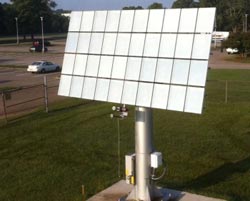Photovoltaics with Record Efficiency

Siemens has a 16-percent stake in the U.S. start-up and wants to develop the technology further. Production of the modules is scheduled to begin in mid-2012.
The record was measured under standardized test conditions in a joint project with the Spanish Instituto de Sistemas Fotovoltaicos de Concentración and the University of Madrid. Classic PV modules made of mono- or poly-crystalline silicon and without concentrating lenses currently achieve efficiency ratings of approximately 20 percent and 16 percent, respectively.
Concentrating PV modules have a glass covering with integrated lenses. The lenses focus the rays of sunlight on small surfaces, and for that reason, the photovoltaic panel does not consist entirely of semiconductor material. Instead, it is made of an inexpensive substrate to which small solar cells are attached. The high-performance concentrator modules from Semprius are based on very small solar cells and achieve a 1,000-fold concentration of the solar radiation.
They rely on a process that Semprius developed for inexpensively mounting tiny solar cells on the substrate: Instead of transferring them chip for chip, a special printing module applies up to 1,000 cells per step. The solar cells themselves are based on multiple layers of light-absorbing III-V semiconductors like gallium arsenide. This technology has already attained an efficiency rating of more than 40 percent in the laboratory.
Concentrating photovoltaic modules can only process direct sunlight and must therefore be set up to track the position of the sun. The technology is particularly suited to regions exposed to a large amount of sunlight. Compared with the solar thermal power plants likewise used in these areas, the high-performance concentrator PV modules also permit smaller units with lower outputs. As Semprius continues to develop the technology of the modules, Siemens is contributing tracking systems and inverters, among other things.
Siemens is also responsible for the design of complete solar power plants based on the new modules. Solutions for photovoltaic plants are part of the Siemens Environmental Portfolio, with which the company generated about €30 billion in sales in the fiscal year 2011.
Media Contact
More Information:
http://www.siemens.com/innovationnewsAll latest news from the category: Power and Electrical Engineering
This topic covers issues related to energy generation, conversion, transportation and consumption and how the industry is addressing the challenge of energy efficiency in general.
innovations-report provides in-depth and informative reports and articles on subjects ranging from wind energy, fuel cell technology, solar energy, geothermal energy, petroleum, gas, nuclear engineering, alternative energy and energy efficiency to fusion, hydrogen and superconductor technologies.
Newest articles

Properties of new materials for microchips
… can now be measured well. Reseachers of Delft University of Technology demonstrated measuring performance properties of ultrathin silicon membranes. Making ever smaller and more powerful chips requires new ultrathin…

Floating solar’s potential
… to support sustainable development by addressing climate, water, and energy goals holistically. A new study published this week in Nature Energy raises the potential for floating solar photovoltaics (FPV)…

Skyrmions move at record speeds
… a step towards the computing of the future. An international research team led by scientists from the CNRS1 has discovered that the magnetic nanobubbles2 known as skyrmions can be…





















